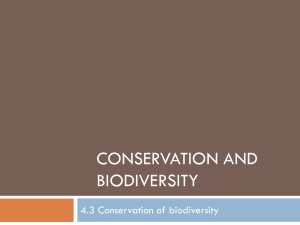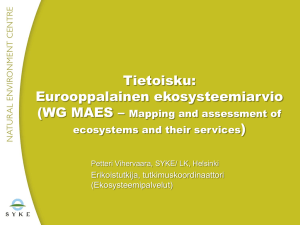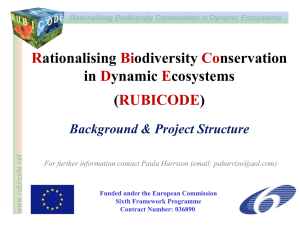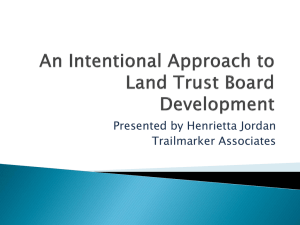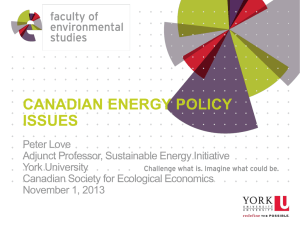Integrating ecosystem services and biodiversity
advertisement
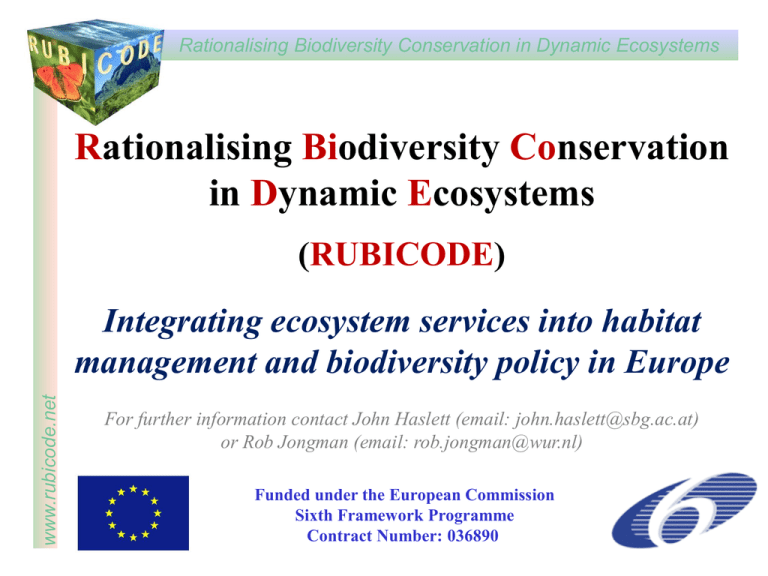
Rationalising Biodiversity Conservation in Dynamic Ecosystems Rationalising Biodiversity Conservation in Dynamic Ecosystems (RUBICODE) www.rubicode.net Integrating ecosystem services into habitat management and biodiversity policy in Europe For further information contact John Haslett (email: john.haslett@sbg.ac.at) or Rob Jongman (email: rob.jongman@wur.nl) Funded under the European Commission Sixth Framework Programme Contract Number: 036890 Rationalising Biodiversity Conservation in Dynamic Ecosystems www.rubicode.net Presentation outline • Present conservation strategies – Protected Areas and networks. • The importance of non-protected areas – Ecosystem service provision and the wider landscape. • The example of agriculture and the Common Agricultural Policy (CAP). • An in-depth analysis of conservation policy – the views of stakeholders in France, Germany and Hungary. • General limitations of present conservation strategies. • A new framework for conservation in Europe encompassing ecosystem dynamics and ecosystem service provision. • Some gaps in present knowledge that still require attention. Rationalising Biodiversity Conservation in Dynamic Ecosystems Present conservation strategies www.rubicode.net • Habitat protection is now recognised as a prerequisite for species survival. • As a result, a continuous, overlapping spectrum of valid conservation strategies, encompassing species and their habitats, is covered by present legislation, e.g. Bern Convention (CoE), Habitats Directive (EU) & others. Rationalising Biodiversity Conservation in Dynamic Ecosystems The established approach relies on Protected Area (PA) management www.rubicode.net • Protected Areas play a central role in conservation strategies and policy – many different instruments covering all levels. • Six IUCN categories of Protected Areas with a gradient of management intervention to meet different needs in different situations. • European Protected Areas are no longer very efficient – interests and emphasis have changed from PA design and inventorying to management for sustainable development. Rationalising Biodiversity Conservation in Dynamic Ecosystems The Emerald and Natura 2000 network • The EU Natura 2000 network of Protected Areas forms part of the wider Emerald Network of the Bern Convention. Areas are identified by the individual Member States. www.rubicode.net • The Natura 2000 network is comprised of Special Bird Protection Areas (SPA), Special Areas of Conservation (SAC) and Marine Protected Areas (MPA). • Numbers and sizes of the designated PAs differs greatly between Member States. • Integration of the Emerald and Natura 2000 areas into the wider landscape has not been realised. Rationalising Biodiversity Conservation in Dynamic Ecosystems www.rubicode.net The density of Natura 2000 sites differs in France and Germany Rationalising Biodiversity Conservation in Dynamic Ecosystems www.rubicode.net Non-protected areas • Most land in Europe is not protected and much biodiversity is outside Protected Areas. • Organisms disperse naturally across landscapes – the resulting distribution patterns are important for species heterogeneity and ecosystem function. • Large scale management of non-PA’s may be helped through the Landscape Convention. • Ecological linkages between PAs are essential, but not enough by themselves. Rationalising Biodiversity Conservation in Dynamic Ecosystems Biodiversity within and outside PAs also delivers ecosystem services www.rubicode.net Ecosystem services need to be protected together with species and habitats because: • They are essential for human well-being; • They are a currency to value ecosystems and promote their sustainable use; • They offer a value-added strategy to supplement presently established biodiversity conservation. Rationalising Biodiversity Conservation in Dynamic Ecosystems Biodiversity conservation outside PAs: Agriculture and the CAP • Within RUBICODE, CAP analysed in 7 case studies selected based on the following criteria: – the approval of the RDPs; – availability of an English translation; – maximum diversity (geographical, social and economical). www.rubicode.net • Selected countries and regions: – – – – – – – Hungary; Ireland; Italy- Veneto; Lithuania; the Netherlands; Sweden; UK- England. Rationalising Biodiversity Conservation in Dynamic Ecosystems Agriculture and biodiversity www.rubicode.net • Many Red List species depend on grassland. • Several priority habitats depend on farming. • High Nature Value (HNV) farmland varies between states up to 25% in Ireland. • Less Favourable Areas (LFAs) vary greatly: – – – – – – Ireland = 75%; Sweden = 50%; Veneto = 46%; Lithuania = 43.5%; England = 24%; Hungary, the Netherlands < 10%. • Natura 2000 areas can also contain farmland: – Sweden: 110,000 hectares in LFAs designated as Natura 2000; – 40% of the English LFA is within National Park boundaries. Rationalising Biodiversity Conservation in Dynamic Ecosystems No standardisation between member states • No commonly agreed definition for ‘rural’. • EC commission uses the OECD definition. www.rubicode.net • According to OECD standards: Sweden is 99% rural, the Netherlands 0%. • Most national Rural Development Programmes (RDPs) provide definitions that suit the national circumstances and are not comparable. • HNV is used but a definition is rarely provided nor statistics addressing HNV farmland. Rationalising Biodiversity Conservation in Dynamic Ecosystems Second pillar of the CAP is the basis for RDPs The second Pillar consists of four axes, namely: • Axis 1: improving the competitiveness of the agricultural and forestry sector; www.rubicode.net • Axis 2: improving the environment and the countryside; • Axis 3: the quality of life in rural areas and diversification of the rural economy; • Axis 4: Leader, building local capacity for employment and diversification (EC 1698/2005). Rationalising Biodiversity Conservation in Dynamic Ecosystems Threats for farmland biodiversity Land abandonment Hungary xx Ireland xx xx www.rubicode.net Sweden UK: England xx x x xx Netherlands Land use change (other than agriculture) x xx Italy: Veneto Lithuania Intensification x x xx Please note xx stands for major challenge for farmland biodiversity conservation; x a challenge for biodiversity conservation, however it is usually limited to a number of areas. These categorisations were made based on the information provided in the RDPs. Rationalising Biodiversity Conservation in Dynamic Ecosystems In-depth Analysis of Nature Conservation Policies • 3 countries analysed: France, Germany and Hungary. • Semi-structured interviews undertaken with key national stakeholders. www.rubicode.net • Analysis of key policy documents. • Country reports. Rationalising Biodiversity Conservation in Dynamic Ecosystems Results from the interviews Biodiversity conservation and ecosystem services: • Ecosystem services is an important concept to convince people about the necessity of nature conservation. • However, it is hard to get “ecosystem service” ideas accepted. www.rubicode.net • Attributing an economic value to natural biological resources is a good idea. • Traditional concepts of conservation have a limited perspective. There is a need for approaches with a wider spectrum, including temporal and spatial dynamics. Rationalising Biodiversity Conservation in Dynamic Ecosystems Results from the interviews www.rubicode.net Public Participation in Biodiversity Conservation: • Public participation is recognised as of increasing importance: “NGOs and also companies, local governments and professional groups in direct contact with nature (such as farmers, fishers) as well as the general public have to be more involved if we want to change gear”. • There is an increasing participatory role of NGOs. Rationalising Biodiversity Conservation in Dynamic Ecosystems Results from the interviews General priorities: • To improve the efficiency of bridging scientific knowledge and policies; www.rubicode.net • To set more quantitative targets for nature conservation (such as for climate change or pesticide reduction); • To integrate biodiversity conservation into other policy fields; • To promote the importance of soil and water protection as well as species and biotope protection. Rationalising Biodiversity Conservation in Dynamic Ecosystems Limitations of current conservation strategies • Reasons for conservation have been largely aesthetic – only just starting to include socio-economic aspects. www.rubicode.net • Most institutions and instruments assume spatially and temporally static situations. • Conservation is considered primarily at human scales, involving “simple” spatial habitat mosaics. • Conservation relies heavily on PAs and networks, even though ecological corridor functioning is still unclear. • Invertebrates under-represented at all levels. Rationalising Biodiversity Conservation in Dynamic Ecosystems Framework for integrating ecosystem services into conservation (part 1) Human aesthetic, cultural and moral values Species/habitat protection www.rubicode.net Conservation policy and management strategy Static site-based PAs & networks Rationalising Biodiversity Conservation in Dynamic Ecosystems ES & conservation framework (part 2) Ecosystem service provision Societal needs www.rubicode.net Human aesthetic, cultural and moral values Management for sustainable ecosystem services Species/habitat protection Conservation policy and management strategy Sectoral policy and management Static site-based PAs & networks Ecosystem sustainability and integrity Conservation within socio-ecological systems Rationalising Biodiversity Conservation in Dynamic Ecosystems www.rubicode.net Gaps in knowledge and practice that require attention (I) • A more dynamic approach that takes account of ecosystem dynamics. • Managing spatial mosaic heterogeneity must be bound to temporal change, recognising climate and land use change. • Nested spatial scales: View habitat mosaics from the “organism point of view” in addition to human landscape perspectives. • Inclusion of invertebrates in habitat management decisions and legislation – these animals form most biodiversity and have many essential ecosystem functions and services across a wide range of scales. Rationalising Biodiversity Conservation in Dynamic Ecosystems Gaps in knowledge and practice that require attention (II) • Integration of conservation strategies and policy with other sectors – agriculture, transport, industry, etc. www.rubicode.net • Knowledge on balancing the conflicts between economic service provision and biodiversity conservation. • Inclusion of the sustainable provision of ecosystem services within the bounds of management for conservation would be one way to add value to present conservation management strategies.



